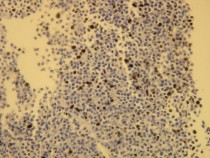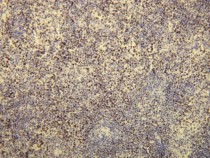ARG10575
anti-Ki-67 antibody [E18-E]
anti-Ki-67 antibody [E18-E] for ICC/IF,IHC-Formalin-fixed paraffin-embedded sections and Human
Microvascular Density Study antibody; Proliferation Marker antibody
Overview
| Product Description | Rabbit Monoclonal antibody [E18-E] recognizes Ki-67 |
|---|---|
| Tested Reactivity | Hu |
| Tested Application | ICC/IF, IHC-P |
| Host | Rabbit |
| Clonality | Monoclonal |
| Clone | E18-E |
| Isotype | IgG |
| Target Name | Ki-67 |
| Antigen Species | Human |
| Immunogen | Synthetic peptide around the N-terminus of Human Ki-67 |
| Conjugation | Un-conjugated |
| Alternate Names | Antigen KI-67; MIB-; KIA; MIB-1; PPP1R105 |
Application Instructions
| Application Suggestion |
|
||||||
|---|---|---|---|---|---|---|---|
| Application Note | * The dilutions indicate recommended starting dilutions and the optimal dilutions or concentrations should be determined by the scientist. |
Properties
| Form | Liquid |
|---|---|
| Buffer | 20 mM Tris-HCl (pH 8.0), 0.05% Sodium azide and 20 mg/ml BSA |
| Preservative | 0.05% Sodium azide |
| Stabilizer | 20 mg/ml BSA |
| Storage Instruction | For continuous use, store undiluted antibody at 2-8°C for up to a week. For long-term storage, aliquot and store at -20°C or below. Storage in frost free freezers is not recommended. Avoid repeated freeze/thaw cycles. Suggest spin the vial prior to opening. The antibody solution should be gently mixed before use. |
| Note | For laboratory research only, not for drug, diagnostic or other use. |
Bioinformation
| Database Links | |
|---|---|
| Gene Symbol | MKI67 |
| Gene Full Name | marker of proliferation Ki-67 |
| Background | Ki-67 is a nuclear protein. It is associated with and may be necessary for cellular proliferation. Alternatively spliced transcript variants have been described. A related pseudogene exists on chromosome X. [provided by RefSeq, Mar 2009] |
| Function | Ki-67 required to maintain individual mitotic chromosomes dispersed in the cytoplasm following nuclear envelope disassembly (PubMed:27362226). Associates with the surface of the mitotic chromosome, the perichromosomal layer, and covers a substantial fraction of the chromosome surface (PubMed:27362226). Prevents chromosomes from collapsing into a single chromatin mass by forming a steric and electrostatic charge barrier: the protein has a high net electrical charge and acts as a surfactant, dispersing chromosomes and enabling independent chromosome motility (PubMed:27362226). Binds DNA, with a preference for supercoiled DNA and AT-rich DNA (PubMed:10878551). Does not contribute to the internal structure of mitotic chromosomes. May play a role in chromatin organization (PubMed:24867636). It is however unclear whether it plays a direct role in chromatin organization or whether it is an indirect consequence of its function in maintaining mitotic chromosomes dispersed (Probable). [UniProt] |
| Research Area | Microvascular Density Study antibody; Proliferation Marker antibody |
| Calculated MW | 359 kDa |
| PTM | Phosphorylated. Hyperphosphorylated in mitosis (PubMed:10502411, PubMed:10653604). Hyperphosphorylated form does not bind DNA. |
Images (3) Click the Picture to Zoom In
-
ARG10575 anti-Ki-67 antibody [E18-E] ICC/IF image
Immunocytochemistry: HEK293 cells stained with ARG10575 anti-Ki-67 antibody [E18-E] at 1:100 dilution.
-
ARG10575 anti-Ki-67 antibody [E18-E] IHC-P image
Immunohistochemistry: Formalin fixed, paraffin embedded Human plasma cell myeloma in the bone marrow biopsy (4 µm sections) stained with ARG10575 anti-Ki-67 antibody [E18-E].
-
ARG10575 anti-Ki-67 antibody [E18-E] IHC-P image
Immunohistochemistry: Formalin fixed, paraffin embedded Human B-cell lymphoma showing high proliferating index (4 µm sections) stained with ARG10575 anti-Ki-67 antibody [E18-E].







